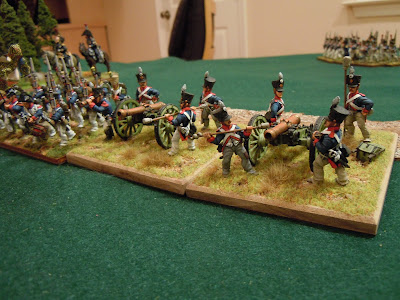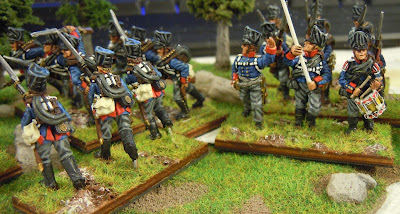The Eichberg Series:
Part One,
Part Two,
Part Three,
Part Four,
Part Five
De Tolly's Gambit: Milkel
This scenario is one of a series of counter-factual scenarios for the "mini-campaign" of Barclay de Tolly just prior to Bautzen. Due to the central location of Milkel and its position along several highways it will be the setting for two scenarios. This first scenario essentially assumes the French forces act as historically and the Russo-Prussian forces, through superior reconnaissance/luck, concentrate their forces instead of more or less blundering into the 15th Division and V Corps. The next post will detail the reverse, a historical Russo-Prussian force with a more active French force.
History and Counter-factual Assumptions:
For the background see
Part One. For purposes of this scenario we assume that the French act historically, e,g Bertrand's IV Corps remains at Bautzen, except for 15th Division which marches to Konigswartha; Lauriston's V Corps continues its march on Klix via Steinitz and Milkel.
For the Russo-Prussian forces we assume either 1) Better Reconnaissance/More Cossack were allocated to expedition which was able to locate V Corps before blundering in to it, OR; 2) Barclay de Tolly choose to step off at 3 a.m. instead of 1 a.m. (or delayed the Russian columns until 3 a.m.).
Whether because of superior intelligence or because Barclay wanted two more hours of rest. Lageron has just arrived at Milkel, Raiewski's Grenadiers are coming up in reserve. The Prussians are on their longer march and are expected to arrive from the north.
The French 18th Division, vanguard of Lauriston's V Corps, marched through Weissig uneventfully at approximately 2 p.m. It is 4 miles from Weissig to Milkel. At around 4 p.m. the leading elements of 18th Division encounter Russian forces at Milkel.
Orders of Battle:
Unit Ratings are based upon Bowden's Empire V, translated roughly to C&GII. Units have been amalgamated to fit our groups basing. The French are based on Bowden and Nafziger. The Allies Nafziger, supplemented by Hofschorer. Note for the allies neither source gives actual numbers for some of the Russian divisions, and were therefore estimated. Estimate Russian Regiments were assumed to have 1 battalion of 480 men.
C&GII generally recommends a ratio of 1 officer per 3 tactical units total. The Russians are clearly over-officered, but I wanted to show the general structure of the OOB for potential use in other rulesets and have in fact combined a few brigades already. The Prussians Brigade commanders are labeled as Divisions in the OOB. The "brigade" commanders in the OOB are actually regimental commanders, which per the Prussian system of standard deployment were put in charge of one of the "lines" of troops.
France:
Note that most of V Corps consists of Regiments 135-155 which were formed from the "Cohorts", or men called up as a reserve when Napoleon started his Russian expedition in 1812. Bowden goes into some detail about the formation of the cohorts and their training (or lack thereof). It should be noted he indicates they do not have elite companies, only center companies and in Empire V terms are only allowed to enter into "semi-skirmish" formation. To translate this into C&G, I did tick the box for skirmish capable, but these units should not be allowed to skirmish offensively. This allows for the use of open order, which is somewhat analogous to "semi-skirmish" and needed given the amount of disruptive terrain on the table.
Allies:
Note: Yorck's Corps had a half battery of 3lbers, which I have chosen to distribute as regimental guns. If regimental guns brings back bad memories of 1806, can always run them as a battery. This is the entire Allied force. As is discussed below how not all of these troops may need to be engaged.
Terrain:
Milkel is part of the
"Oberlausitzer Heide- und Teichlandschaft"/Upper Lusatian Moorland which is to say there are a lot of water (ponds, streams) and wooded areas. The German Wikipedia page for the town of Milkel indicates the population in 1890 was 358. The Schloss and church in the town were present in 1813. The Klein Spree runs just north of the village and the village is the intersection of the roads from Wartha/Steinitz, Konigswartha, Klix, Bautzen, and Uhyst.
The Red Boxs are 12.5ft x 6ft table at 1"=25paces (28mm)
Counter-Factual Historical Scenarios:
As described above in the history section the French movements have been held historical. Through either delay, luck, or better intel, the Allies have achieved their goal of catching V Corps separated from supporting formations while concentrating the forces of the Allied expedition. Both of the variations below can be scaled to fit your table, troops, and number of players. As noted you could bring the whole allied expedition and all of V Corps if you have the time and space to play it out.
Reinforcements:
The first allied troops to arrive in either variation is likely Langeron's Russian Infantry Divisions. They have the direct march to Milkel and historically the three allied columns all stepped off at the same time. Next would be Tschaplitz's Vanguard, followed by von Yorck's Prussians who have the longest route. Personally, I would omit Tschaplitz to keep the scenario manageable, and to model any of the following counter-factuals: (a) the dispersion of the vanguard troops (cavalry especially) to achieve the superior intel (coupled with stepping off at 1 a.m. per history), or (b) screening force to the southwest of Milkel observing a possible advance by Bertrand's IV Corps, or (c) Tschaplitz scouts forward toward Konigswartha (and his historical orders), and meets his date with destiny and the foragers of the Italian 15th Division (casualties inflicted may not be as high without the reinforcements from the main Russian column, but Tschaplitz could likely over run the foraging parties just the same.)
For the French its fairly straightforward, the divisions come up in the assumed historical order 18th, 16th, 19th (based on the historical casualty returns). The only potential variation to this is Peyri's 15th Division marching to the sound of the guns (assuming they went unmolested by Tschaplitz). III Corps is unlikely to play a role; its vanguard only reaching Wartha around 5 p.m. which is just under eight miles from Milkel.
Fatigue:
As noted in the Eichberg scenario this can be customized to suit your goals for the game (more fatigue=slower game). All forces have been marching for most of the day. Even with rest periods 50% fatigue is arguably generous. The Prussians and V Corps have had the longest marches. Langeron/Raevsky have had the shortest. At a minimum I would set everyone to "acceptable" (80%) or "tiring" (60%).
Start and End Times:
Start between 3:30 and 4:30 representing V Corps march of 4 miles from their historical position at Weissig around 2:30-3:00 p.m.
Sunsets at 8:15 and "military dark" is at 9:30 (per Empire Campaign System for Saxony region).
Terrain:
The Klein Spree is fordable, but is disruptive terrain. The woods are medium woods. The ponds are impassable. Lippitsch and Milkel are wooden structures. I suggest placing additional light/medium cover lineal obstacles (fences, orchards, outbuildings) to represent the rest of Milkel and Teicha.
Variation One "Set Piece" Combat:
Langeron starts deployed in Milkel/Teicha. V Corps enters along the Oppitz/Konigswartha road. Randomize the arrival of Ravesky and von Yorck (and Tschaplitz if his command is not used elsewhere). I would delay von Yorck at least an hour, if not more. Prussians can enter on road to Lippitsch or Uhyst. Raevesky should arrive in road column. Bring the flanking allied forces in battle formation, unless there are French forces within 24 inches of the table edge. For French I would suggest making sure the second division arrives within the first hour in order.
Or ignore the above, setup Langeron and Raevesky on table and all of V Corps and play this as a set piece slug-fest, with de Tolly playing for time for von Yorck to deliver the decisive blow.
Variation Two "Envelopment":
By playing the table on the other axis we have the potential for a meeting engagement. This is all counter-factual so there is no "right" answer. Place the two forces equidistant from the town and start things off with a fierce struggle. Or the Russians can let the French have Milkel (purposely or other wise), and set the pieces in motion for a single or double envelopment or a deft French tactical withdrawal in the face of certain defeat.
Conclusion:
The possibilities and variations are numerous and for my two cents the counter-factual assumptions needed to bring them about are not terribly unreasonable or out of the realm of possibility. de Tolly essentially needs to draw out V Corps, by letting them continue their march. The Allies stepping off an hour or two later potentially sets all such requirements in motion.
Next Up: Counter-factual Scenario Two: Milkel-Allied Disaster! and the first Milkel Playtest AAR.













































